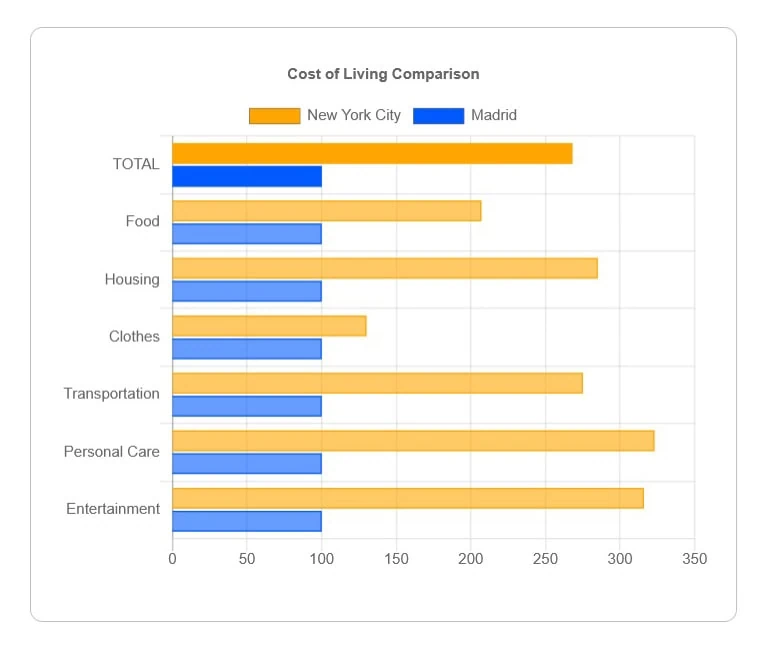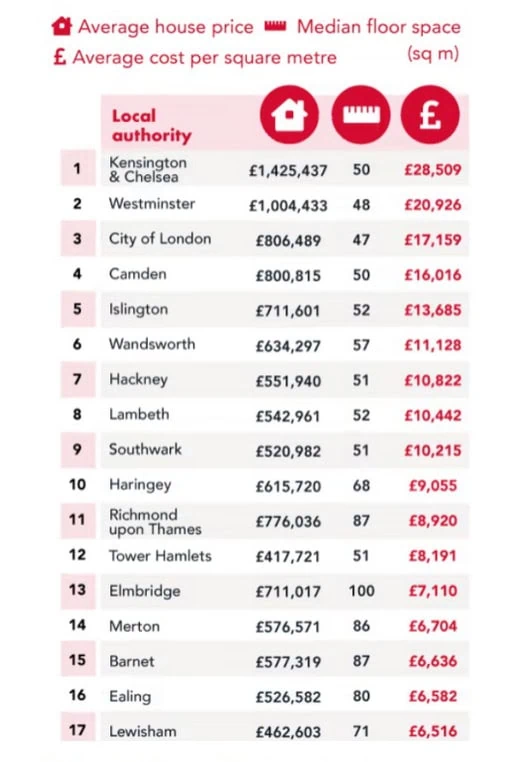As prices soar in most places in the world, cost of living has become an increasing concern for most people. Supply chains continue to be disrupted and diseases like bird flu are contracting product supply, thus most people expect this trend to continue. Since the political situation in the US and much of Europe is increasingly volatile, many people are considering relocating. Given these trends, we thought it would be interesting to examine the cost of living in Madrid vs. NYC and London.
What exactly is the cost of living?
The cost of living refers to the money needed for essentials like housing, food, taxes, and healthcare in a specific location and time. It is often used to compare the expenses of living in different cities. Higher living costs, like in New York, require higher salaries to afford living in the area.
There is an additional reason why the cost of living is important: wealth creation from savings. Put simply, what you save from your paycheck you can invest. Different investment vehicles are optimal for different people. For some people, investing in a money market firm is sufficient. Others may want to invest in the equity markets, whereas others may want to save to purchase a home, secondary house or rental properties.
Most investment advisors recommend you save 20% of your paycheck. This is part of a popular budgeting rule that’s referred to as the 50/30/20 strategy, which means you should allocate 50% of your paycheck toward the things you need including rent or your mortgage payment, 30% toward the things you want and 20% toward savings and investments. If you live in a city with a low cost of living you can usually save more. For example, let’s assume you make $150,000 per year. If you live in a city with a relatively low cost of living, like Madrid, you could easily save $50,000 per year, or much more if you are frugal. If you live in a high cost of living city, like NYC, you will probably not only be able to save anything, but you will probably need to go into credit card debt to maintain a comfortable standard of living.

The cost of living is calculated using cost of living indices. These indices compare the cost of living in one area to another. They incorporate various living expenses, creating an aggregate measure that is used as a benchmark (the value of the benchmark is typically 100). These are used to accurately compare different places based on their aggregate numbers. Typically, a higher number represents a more expensive place to live. There isn’t one main cost of living index; they are calculated by many different entities.
Cost of living in Madrid vs. NYC & London
Since many of the inquiries we get about relocating to Madrid come from people in the US or the UK, we thought it would be helpful to compare the cost of living in these two cities to that of Madrid.
Cost of living in Madrid vs. NYC
New York City consistently ranks as one of the most expensive cities in the world. One of the main components of this, but not the only one, is its high real estate prices.
According to StreetEasy, the average price of real estate in New York County is $18,612 per square foot. Converting this into square meters yields and average price per square meter of $17,351. This number in euros is fluid, depending upon current exchange rates. Using an exchange rate of .95 €/$ yields an average price of 16,484€ per square meter. However, there is great variation among neighborhoods. Pricing in downtown neighborhoods, such as TriBeCa, or on streets bordering Central Park in the UES and UWS, can run much higher. The price of real estate in some ultra premium new constructions is eye watering. On the flip side, if you go to the outer boroughs like Staten Island, the prices are much cheaper.
According to Indomio, the average price of real estate in Madrid is currently 6,021€. As in NYC, this does vary greatly by neighborhood. The average price per square meter in Salamanca, the most expensive neighborhood in Madrid, was 9,589€ in April 2025. This increases to 10,908€/m2 in Recoletos. Conversely, in Tetuán the average price per square meter was 5,306€/m2.
Although real estate prices in NYC are extremely high compared to those in Madrid, NYC is significantly more expensive than Madrid across every indicator in cost of living indices.

A very large component of living expenses for many Americans is healthcare. Americans pay significantly more per healthcare than residents of all other countries in the world:
Healthcare costs in the US also vary greatly by state and one’s income; New York State has relatively high healthcare costs. Moreover, since most people that live in New York County have extremely high incomes, they pay significantly more than depicted in the above chart.
New Yorkers also pay significantly more than Madrileños for entertainment and transportation. For example, a monthly parking spot is $600-$1200 per month, depending upon the size of the vehicle.
To learn more about why NYC investors are increasingly choosing Madrid, we invite you to read: From NYC to Madrid, why NYC investors are increasingly choosing Madrid
Cost of living in Madrid vs. London
London is one of the more expensive cities in the world. Again, for most people housing costs are the priciest item in their living expenses. Although London real estate prices have trended down since Brexit (it used to be the most expensive in Europe), it is still quite expensive relative to other cities. Paris is the only city in Europe that has more expensive real estate (not counting Monaco which we don’t cover because it skews our numbers). Real estate in London is definitely more expensive than in Madrid:
The average price per square meter for houses in London is around £7.0k. However, this is a little misleading. London is a very large city. Even pricing in Inner London (depicted in the above graphic) can vary significantly depending on the location.
London, like NYC, has premium neighborhoods where pricing is much higher than the average. Real estate prices in the City of London average £17,159 per square meter. Real estate prices in Westminster average £20,926 per square meter. The most expensive real estate in London is found in the Royal Borough of Kensington & Chelsea, where prices average £28,509 per square meter.

Almost every other component in the cost of living indices is more expensive in London than Madrid, with the exception of personal care. In terms of insurance, the UK has the NHS which provides free healthcare to citizens. Private healthcare is available, but most people use the NHS.
Transportation in London is much more expensive than that in Madrid. The price of a Metro ticket in the city center ranges between 1.50€ and 2€ (€1.50 for up to five stations; €0.10 for each additional station, up to a maximum of €2.00 for routes over nine stations). London Underground pricing is much more expensive. A single cash fare starts at £7.00 (though this drops to £2.90 if you have an Oyster card), and can go up to £10.30 if you travel to Zone 9 (£8.30 with an Oyster card). If you want to drive into the city, you must pay a £15 congestion pricing charge each time.
The prices of other items in the cost of living indices show London to be more expensive than Madrid, but not by the stunning amounts seen in NYC pricing.
Conclusion
Housing prices are typically a household’s biggest expenditure- in cities with expensive real estate, like NYC and London, it can be 40% or more of a household’s monthly budget. Given Madrid’s relatively low housing prices, the cost of living in Madrid is much lower than in New York City or London. If you take housing prices out of the equation, the costs of living in London and NYC are still greater than in Madrid. However, London pricing is closer to that of Madrid in most categories except for transportation. The cost of living in NYC is much greater than in Madrid, even if you remove housing prices from the equation.
Although Madrid has become more expensive in recent years, the cost of living in Madrid in 2025 is, as we’ve seen, much cheaper than that in NYC and London. It’s really the best of both worlds: you can live cheaply but if you want to splurge, there is an increasing number of options available. The biggest savings come in terms of necessities like housing and transportation.